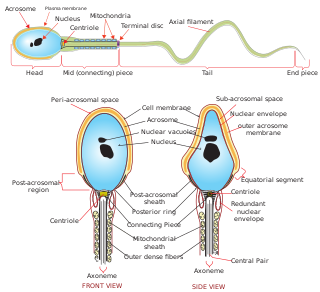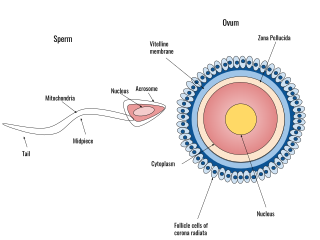Related Research Articles

A gamete is a haploid cell that fuses with another haploid cell during fertilization in organisms that reproduce sexually. Gametes are an organism's reproductive cells, also referred to as sex cells. In species that produce two morphologically distinct types of gametes, and in which each individual produces only one type, a female is any individual that produces the larger type of gamete—called an ovum— and a male produces the smaller type—called a sperm. Sperm cells or spermatozoa are small and motile due to the flagellum, a tail-shaped structure that allows the cell to propel and move. In contrast, each egg cell or ovum is relatively large and non-motile. In short a gamete is an egg cell or a sperm. In animals, ova mature in the ovaries of females and sperm develop in the testes of males. During fertilization, a spermatozoon and ovum unite to form a new diploid organism. Gametes carry half the genetic information of an individual, one ploidy of each type, and are created through meiosis, in which a germ cell undergoes two fissions, resulting in the production of four gametes. In biology, the type of gamete an organism produces determines the classification of its sex.
Genomic imprinting is an epigenetic phenomenon that causes genes to be expressed or not, depending on whether they are inherited from the mother or the father. Genes can also be partially imprinted. Partial imprinting occurs when alleles from both parents are differently expressed rather than complete expression and complete suppression of one parent's allele. Forms of genomic imprinting have been demonstrated in fungi, plants and animals. In 2014, there were about 150 imprinted genes known in mice and about half that in humans. As of 2019, 260 imprinted genes have been reported in mice and 228 in humans.

Reproduction is the biological process by which new individual organisms – "offspring" – are produced from their "parent" or parents. Reproduction is a fundamental feature of all known life; each individual organism exists as the result of reproduction. There are two forms of reproduction: asexual and sexual.

A spermatozoon is a motile sperm cell, or moving form of the haploid cell that is the male gamete. A spermatozoon joins an ovum to form a zygote.

Fertilisation or fertilization, also known as generative fertilisation, syngamy and impregnation, is the fusion of gametes to give rise to a new individual organism or offspring and initiate its development. While processes such as insemination or pollination which happen before the fusion of gametes are also sometimes informally referred to as fertilisation, these are technically separate processes. The cycle of fertilisation and development of new individuals is called sexual reproduction. During double fertilisation in angiosperms the haploid male gamete combines with two haploid polar nuclei to form a triploid primary endosperm nucleus by the process of vegetative fertilisation.
Reproductive technology encompasses all current and anticipated uses of technology in human and animal reproduction, including assisted reproductive technology, contraception and others. It is also termed Assisted Reproductive Technology, where it entails an array of appliances and procedures that enable the realization of safe, improved and healthier reproduction. While this is not true of all people, for an array of married couples, the ability to have children is vital. But through the technology, infertile couples have been provided with options that would allow them to conceive children.

During fertilization, a sperm must first fuse with the plasma membrane and then penetrate the female egg cell to fertilize it. Fusing to the egg cell usually causes little problem, whereas penetrating through the egg's hard shell or extracellular matrix can be more difficult. Therefore, sperm cells go through a process known as the acrosome reaction, which is the reaction that occurs in the acrosome of the sperm as it approaches the egg.
An oocyte, oöcyte, or ovocyte is a female gametocyte or germ cell involved in reproduction. In other words, it is an immature ovum, or egg cell. An oocyte is produced in a female fetus in the ovary during female gametogenesis. The female germ cells produce a primordial germ cell (PGC), which then undergoes mitosis, forming oogonia. During oogenesis, the oogonia become primary oocytes. An oocyte is a form of genetic material that can be collected for cryoconservation.

Kaguya was a mouse that had two parents of the same sex. She was named after a Japanese folk tale, in which the Moon-born princess Kaguya (Kaguya-hime) is found as a baby inside a bamboo stalk.

Sperm is the male reproductive cell, or gamete, in anisogamous forms of sexual reproduction. Animals produce motile sperm with a tail known as a flagellum, which are known as spermatozoa, while some red algae and fungi produce non-motile sperm cells, known as spermatia. Flowering plants contain non-motile sperm inside pollen, while some more basal plants like ferns and some gymnosperms have motile sperm.

Human fertilization is the union of a human egg and sperm, occurring primarily in the ampulla of the fallopian tube. The result of this union leads to the production of a fertilized egg called a zygote, initiating embryonic development. Scientists discovered the dynamics of human fertilization in the nineteenth century.

Haplodiploidy is a sex-determination system in which males develop from unfertilized eggs and are haploid, and females develop from fertilized eggs and are diploid. Haplodiploidy is sometimes called arrhenotoky.

Parthenogenesis is a natural form of asexual reproduction in which growth and development of embryos occur in a gamete without combining with another gamete. In animals, parthenogenesis means development of an embryo from an unfertilized egg cell. In plants, parthenogenesis is a component process of apomixis. In algae, parthenogenesis can mean the development of an embryo from either an individual sperm or an individual egg.
Female sperm can refer to either:
- A sperm which contains an X chromosome, produced in the usual way in the testicles, referring to the occurrence of such a sperm fertilizing an egg and giving birth to a female.
- A sperm which artificially contains genetic material from a female.

Sexual reproduction is a type of reproduction that involves a complex life cycle in which a gamete with a single set of chromosomes combines with another gamete to produce a zygote that develops into an organism composed of cells with two sets of chromosomes (diploid). This is typical in animals, though the number of chromosome sets and how that number changes in sexual reproduction varies, especially among plants, fungi, and other eukaryotes.
Oocyteactivation is a series of processes that occur in the oocyte during fertilization.

Juno also known as folate receptor 4, folate receptor delta or IZUMO1R is a protein that in humans is encoded by the FOLR4 gene. Juno is a member of the folate receptor family and is GPI-anchored to the plasmalemma of the mammalian egg cell that recognizes its sperm-riding counterpart, IZUMO1, and facilitates fertilization. The protein was named after Juno, the Roman goddess of fertility and marriage.
Parthenogenesis is a form of reproduction where eggs develop without fertilization, resulting in unisexual species. This phenomenon is closely related with reproductive modes such as hybridogenesis, where fertilization occurs, but the paternal DNA is not passed on. Among amphibians, it is seen in numerous frog and salamander species, but has not been recorded in caecilians.
Dayu Lin is a neuroscientist and Associate Professor of Psychiatry, Neuroscience and Physiology at the New York University Grossman School of Medicine in New York City. Lin discovered the neural circuits in the hypothalamus that give rise to aggression in mice. Her lab at NYU now probes the neural circuits underlying innate social behaviors, with a focus on aggressive and defensive behaviors.

LGBT reproduction refers to lesbian, gay, bisexual, and transgender (LGBT) people having biological children by means of assisted reproductive technology. It is distinct from LGBT parenting, which is a broader cultural phenomenon including LGBT adoption. In recent decades, developmental biologists have been researching and developing techniques to facilitate same-sex reproduction.
References
- 1 2 Center for Genetics and Society: "Are male eggs and female sperm on the horizon?"
- ↑ "Male Egg - an overview | ScienceDirect Topics". www.sciencedirect.com. Retrieved 2022-03-20.
- ↑ Zhang, Sarah. "How Egg Farms Will Stop Killing Millions of Male Chicks". Wired. ISSN 1059-1028 . Retrieved 2022-03-20.
- ↑ EUROPEAN BIOETHICAL RESEARCH: "CHILDREN WITH TWO GENETIC FATHERS" Archived 2007-07-27 at the Wayback Machine
- ↑ BBC News: "Male-only conception 'highly speculative'"
- ↑ "Breakthrough as eggs made from male mice cells". BBC News. 2023-03-08. Retrieved 2023-03-27.
- ↑ Ledford, Heidi; Kozlov, Max (2023-03-09). "The mice with two dads: scientists create eggs from male cells". Nature. 615 (7952): 379–380. doi:10.1038/d41586-023-00717-7. PMID 36894725. S2CID 257428648.
- ↑ Li, Zhi-Kun; Wang, Le-Yun; Wang, Li-Bin; Feng, Gui-Hai; Yuan, Xue-Wei; Liu, Chao; Xu, Kai; Li, Yu-Huan; Wan, Hai-Feng; Zhang, Ying; Li, Yu-Fei; Li, Xin; Li, Wei; Zhou, Qi; Hu, Bao-Yang (2018-11-01). "Generation of Bimaternal and Bipaternal Mice from Hypomethylated Haploid ESCs with Imprinting Region Deletions". Cell Stem Cell. 23 (5): 665–676.e4. doi: 10.1016/j.stem.2018.09.004 . ISSN 1934-5909. PMID 30318303. S2CID 205251810.
- ↑ "Same-sex mice have babies". BBC News. 2018-10-11. Retrieved 2023-03-27.
- ↑ Rehm, Jeremy (2018-10-11). "Healthy mice from same-sex parents have their own pups". Nature. doi:10.1038/d41586-018-06999-6. S2CID 187285286.